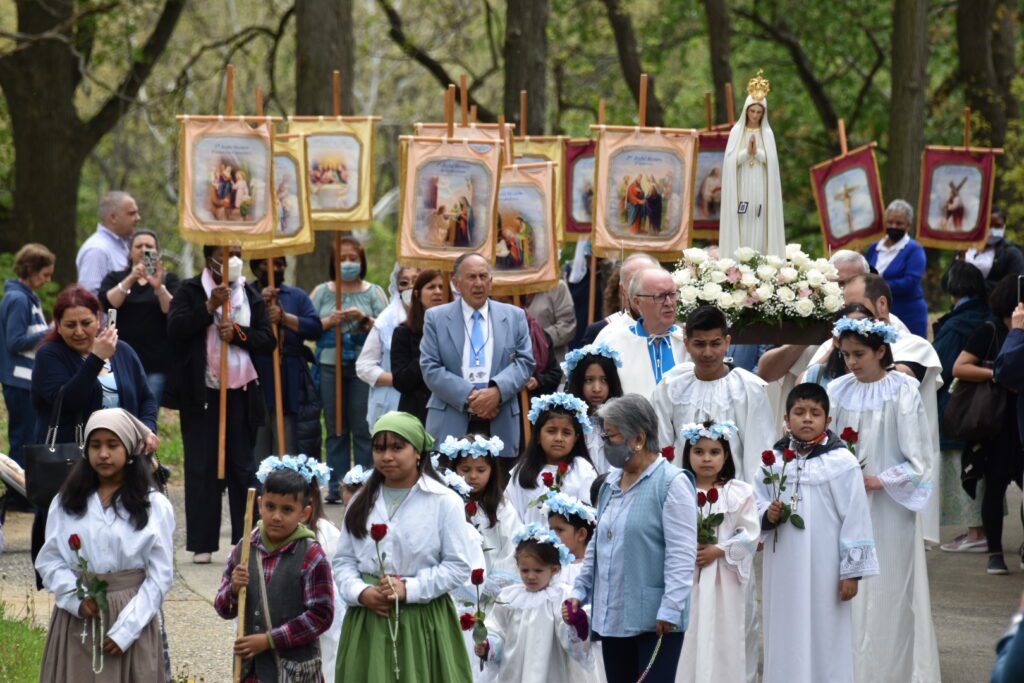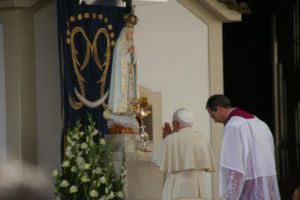by Donal Anthony Foley –


As we enter the Sacred Triduum, the most solemn time of the Church’s year, our focus turns increasingly towards the Passion and death of Christ, as we try to comprehend the extent of His sufferings and what it cost Him to redeem us. One way we can do this is to consider the lives of those Christians who have followed most closely in His footsteps – the martyrs. Of these, the story of St. Jean Gabriel Perboyre (1802 -1840) especially stands out. Fr. Perboyre was a French missionary who traveled to China and gave the ultimate witness to Christ. His death shares a marked resemblance to that of Christ, not only because of the form of crucifixion he endured, but also the details of his sufferings, which parallel those of his Master in a remarkable way.
Jean Gabriel Perboyre was born into a devout Catholic family, one of eight children, five of whom entered the religious life. He joined the Vincentian seminary at Montauban near Toulouse in southwestern France, commencing his novitiate in 1818 and ordained as a missionary priest in 1825. As time went on, he expressed an intense desire to work in China, but his superiors although impressed by his evident holiness, felt that his poor health prevented him from being an active missionary. However, they eventually yielded, and in 1835, he made the lengthy journey to the Far East.
There is a long history of the Church attempting to evangelize China dating back to at least the eighth century, but real progress was only made following the missionary exploits of the great Catholic-Reformation saints, such as St Francis Xavier. In 1794, in the period leading up to the missionary activities of Fr. Perboyre, the Manchurian Emperor Qianlong, proscribed Christianity with a sentence of death for any Europeans who professed it, and exile for any Chinese person who did so. This led to bouts of persecution for believers, the most severe taking place in 1805 and 1820.
After Jean Gabriel arrived in China, he undertook an arduous eight-month journey to the interior of the country by junk, horseback and on foot. He eventually reached Nanyang in Henan province, where he began to learn Chinese. He also began his difficult work as a missionary in China, before being moved to the more southerly Hubei province.
In 1839, there was a fresh outbreak of persecution, and in September of that year, Fr. Perboyre was arrested when his hiding place was betrayed by a catechumen. This was the point at which he began to follow in the footsteps of Christ’s Passion in real earnest. Just as happened in the Garden of Gethsemane, when Judas betrayed Him and Peter wanted to defend Him by force, so Jean Gabriel was betrayed, and after his arrest, one of his companions who was hiding with him offered to resist the soldiers, but the saint refused this.
Fr. Perboyre was loaded with chains and subject to much ill treatment. Then taken before a local Mandarin who was to judge his case, he acknowledged that he was a European and a Catholic missionary. The next day he was forced to march to another city some way off, covered with wounds and weak with fatigue and hunger. One of the pagan officials who saw what was happening, like Simon of Cyrene, offered to help him. After Jean Gabriel’s death, he appeared to this man in a vision, urging him to become a Christian, and in fact, the man was baptized before he died.
Fr. Perboyre was then taken before another Mandarin, the military prefect, and again affirmed that he was a Catholic missionary, after which he maintained silence. The irritated official ordered the soldiers to strike him and he received 100 blows with a bamboo cane before being thrown into prison.
The next day he was again brought before the Mandarin who ordered him to trample on a crucifix, which was placed on the ground. But Jean Gabriel replied: “Though you should kill me, I would never deny my faith or trample upon a cross.” He was told this meant death for him, but the saint said that he would be happy to die for his faith. The mandarin then ordered that he receive 40 blows to the face with a heavy leather strap, an assault that wounded and badly disfigured him.
After further interrogations, and still more ill treatment, he was taken to another town a good distance away, where he was brought before the governor and then a magistrate, who both interrogated him before he was sent on to the capital of the province for his final sentence.
His final journey was a long and very painful one, but despite the grievous ill treatment he suffered during it, he maintained a wonderful constancy and patience.
On arrival at the capital of the province, he was incarcerated in a dreadful prison reserved for the worst criminals, a filth-ridden place full of vermin. He was interrogated more than 20 times, but refused to divulge any details about his fellow priests or the Chinese faithful.
Here he endured further tortures, including being forced to kneel on broken potsherds and iron chains while holding a heavy piece of wood over his head from nine in the morning until the evening. He also had to endure, with great sadness, the apostasy of some lay Christians who were forced to pull out his hair and spit in his face.
He bore every suffering with great patience and never uttered any complaints, and on his return to prison would pour out his soul in prayer to God for all the graces he had received, and in begging pardon for his captors and torturers. Those prayers gave him a supernatural strength, a strength he would need for the final most grueling part of his passion after he was summoned before the viceroy. This man was notorious throughout China for his frightful cruelty and was known, moreover, for his particular hatred for Christians.
This monster in human form forced Fr. Perboyre, on various occasions, to be hung up by the hair for some hours, to be suspended from a type of cross by his hands all day and to be lifted up into to the air and allowed to fall to the ground with a great shock to his whole frame. His captors also forced him to kneel on iron chains while a wooden beam with a man standing at either end was placed across his calves, thus causing him terrible agony. They also suspended him in the air and hung great weights from his feet causing agonizing pains in his knee joints.
In short, his torturers exhausted their imaginations in coming up with ever new ways to inflict pain on Fr. Perboyre, but in all this he never uttered a cry, nor give any details of the Christian community in China. He was instead filled with a supernatural joy at being able to join his sufferings with those of Christ.
At one point, his priestly vestments were brought to him and he was ordered to don them. After a moment’s reflection, he did so, and as with Christ’s Passion, was then stripped of his garments. This was done because the viceroy was convinced that the superhuman patience Fr. Perboyre displayed must have been due to the priest wearing some sort of magic charm or talisman. But all they found was a bandage from an old injury.
Perhaps the most disgusting thing of all was that the viceroy then had a dog killed and part of the blood poured over Fr. Perboyre’s head, while he was forced to drink the rest of it.
Every day brought fresh tortures, including repeated beatings and being racked, all of which reduced Jean Gabriel to a truly pitiful state, covered in blood, his flesh hanging in shreds, some of his bones exposed to view and his whole body one vast wound, as was the case with Christ after his scourging.
It was in fact a miracle that he was still alive after receiving so much ill treatment. And yet, in all this, Fr. Perboyre displayed saintly fortitude, and a witness at this time even saw him on his knees in prayer in the prison.
By January 1840, the saint had been in custody for about four months. At this point, the death sentence was passed on him, but since it was necessary for the emperor to ratify this, Jean Gabriel had to remain a further eight months in prison. From this point on, the harshness of his treatment was somewhat relaxed, and he was able to receive visitors and even go to confession. But to his great regret it was not possible, due to the danger of profanation, for him to receive Holy Communion.
On Sept. 11 1840, the imperial courier finally arrived with the sentence of death, a sentence to be carried out immediately. That day was a Friday, and like Christ on Good Friday, Fr. Perboyre was led to die among criminals, in his case, five in number.
According to an eyewitness, he was wearing the red robe assigned to those condemned to death, with his hands tied behind his back and was forced to carry a long stick which held a banner proclaiming the sentence of death. Here, too, we find a parallel with the inscription that was displayed above Christ when he was crucified.
The most amazing thing about Fr. Perboyre’s final minutes was that his wounds were no longer visible and his face radiated a wonderful supernatural radiance.
The condemned men were all taken to the place of execution, and after the five criminals had been beheaded, it was Fr. Perboyre’s turn. A longer and more painful death was reserved for him, though. He was bound to a gibbet in the form of a cross, a cord was put around his neck and he was strangled.
After his death, it was impossible for many of the bystanders not to notice a beautiful halo, which shone around his head. One of those watching was so struck by this that he immediately converted to Christianity.
Fr. Perboyre was beatified on Nov. 7 1889, by Pope Leo XII, who remarked in the Brief of Beatification about the striking resemblance of his sufferings to that of Christ. He was canonized by St. John Paul II on June 2, 1996. His feast day is September 11.
If the “blood of the martyrs is the seed of the faith,” as the Early Church writer Tertullian said, then surely the blood which St. Jean Gabriel Perboyre shed so abundantly for Christ will play its part in the eventual conversion of China to Christianity, just as the death of Christ led to the conversion of the Rome Empire.
Donal Anthony Foley is the author of a number of books on Marian Apparitions, and maintains a related web site at www.theotokos.org.uk. He has also written two time-travel/adventure books for young people, and the third in the series is due to be published later this year – details can be seen at: http://glaston-chronicles.co.uk













